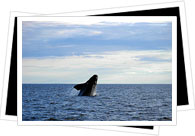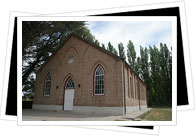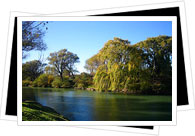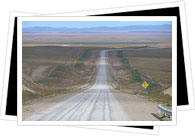
Esquel - This endearing city is nestled within a valley and is characterised by its arid, sandy coloured cliffsides which is unusual for the region which is generally very green. The city itself is laid back and quiet, a good choice for relaxing and brilliantly located for exploring the surrounding areas. Culture vultures will enjoy the Fiesta Provincial del Teatro in October. The winters in Esquel are cold and snowy making this a good choice for heading off to La Hoya Ski Resort and September sees the annual Fiesta Nacional del Esquí, so if you're a slave to the slopes, this is the place to be! Click the link for more information about all of Festivals in Argentina. The mild summers here mean that the mountains surrounding the city are perfect for embarking on a whole host of adventure sports, from mountain biking and rock climbing to hardcore hiking. The nearby lakes are also perfect for fishing, be sure to get a permit beforehand though (see the Argentina Travel Information section for more information.) Nature lovers can witness the incredibly rare, 2500 year old Alerce tree on a visit to the Parque Nacional Los Alerces and it is well worth taking an unforgettable journey on La Trochita, the Patagonian Express - a beautifully restored old steam train which huffs and puffs its way through some beautiful landscapes.
Peninsula Valdés - A sparsely vegetated peninsula whose craggy chalk coloured cliffs poke out into the Atlantic Ocean is an absolute gem for lovers of marine life. Hoards of sea life descend upon the shores of the Valdez Peninsula each year allowing visitors to witness a showcase of natural life at its very best. It is possible to tour the area alone but roads are renowned for being accident prone and we would advise you join one of the many guided tours on offer. The Isla de los Pájaros is a bird lovers haven but is only used for scientific research, however tours should include a trip to the observatory on the mainland from where you can birdwatch to your heart's content. Puerto Pirámides is a little beach village and the best place to catch Southern Right Whales between June and December when they head to the shores for the mating season. Punta Delgada offers good access to the deep salt plains including the Salina Grande which is found 42m below sea level. It is also the place to spot sea lions between September and March and the chosen mating site for over 7000 blubbery elephant seals. Along the coast you can spot dolphins all year long, killer whales from February to May and Seals between September and March. If penguins float your boat then visit the world's largest hatching site for Magellanic penguins at Punto Tumbo (September-March). Named a UNESCO World Heritage Site in 1999 for being an important breeding site for the endangered Southern Right whale, the area is protected by the Reserva Faunística Península Valdés (Valdez Peninsula Wildlife Reserve).

Welsh Argentina in the Chubut Valley - The first Welsh settlers arrived to Argentina in 1865 in search of a place of peace and tranquility where their own traditions, customs and language could be established without the English influence which was so apparent in their European home. Whilst it was quite a task to find farmable land in this arid region, the Welsh travelled through leaving their distinguishable footprints all over the area in the form of architecture, culture and the arts. If you are in the area towards the end of October be sure to catch the Eisteddfodau de Chubut, an annual festival of Welsh literature, music and folklore which is sure to enhance your understanding of this rich culture. Follow the link for more information on festivals in Argentina.
Most visitors arrive at Trelew, a small city on the River Chubut. Trelew has good access to penguin heaven at Punto Tumbo, as well as the small Welsh villages which are found further along the river. Whilst Trelew itself only hints at the intense Welsh culture to be found in the smaller villages, it is worth visiting the pretty Capilla Tabernacl chapel and the Salón San David, the former built by the Welsh in 1889 and the latter in 1913. The Plaza de la Independencia is a charming spot with its ornate gazebo which celebrated Argentina's independence. The Museo Paleontológico Egidio Feruglio contains some interesting artefacts and incredible dinosaur skeletons and the weekend market is a great place to pick up some souvenirs.

Head to Gaiman for a truly Welsh experience in Argentine Patagonia. There is something about this place that draws you in, and the fact that it is so far away from Wales seems to have resulted in a more determined preservation of traditional customs than you would come across in modern day Wales. Spanish is the principle language but many locals (young and old) can be heard conversing in Welsh on a daily basis. The little town exhibits a large amount of traditional cottages and simple, modest architecture characteristic of a small Welsh village - this is something you won't come across anywhere else in the Americas! In Gaiman you can learn all about the history of the Welsh in Argentina at the Museo Histórico Regional Galés and take tea in one of the many traditional tea rooms.

Parque Nacional Los Glaciares - A UNESCO World Heritage site since 1981, this enormous National Park is one of Argentina's most famous attractions. As the second largest park in the country, Los Glaciares covers an absolutely immense 7240 km sq, just under half of which is composed of ice fields and 13 glaciers. Whilst tourists cannot easily access the central section of the park, the north and south ends contain by far enough frozen treasures to keep you 'ooh-ing' and 'ahh-ing' with awe. The most famous of this park's many attractions is the Perito Moreno Glacier which is one of the only advancing glaciers in the world. The antarctic scenery you will witness here is unforgettable as the sun sparkles in on the glacial lakes and illuminates the huge wedges of ice. You will also find dense subatlantic forestry to rumage through and exceptional hiking opportunities in the Northern Fitz Roy Massif sector of the park. For more information on the Parque Nacional los Glaciares and other National Parks in Argentina just click on the link.

Tierra del Fuego (Land of Fire) - Also known as 'El Fin del Mundo' (the end of the world) this remarkable group of islands marks the southernmost point of the world (excluding Antarctica) and is divided two-thirds to Chilean territory and one-third Argentinean. The main island 'isla grande' is the largest in South America and where most people head to. It is important to note that the only way of reaching the Tierra del Fuego is by crossing the Chilean border and entering in to the Chilean side, from there you can explore as you wish. There is a sharp contrast between heavily tourist orientated areas and untouched but somewhat bleak and forgotten parts whose main interest is the rearing of sheep but a trip to the less visited Tolhuin will not be forgotten quickly. The friendly people, dense forests and dramatic cliffs which plunge into the Atlantic make this a very special destination.
An unmissable stop is Argentina's southernmost city, the beautiful Ushuaia. Whilst it is touristy, the magnificent culmination of interesting architecture, thriving nightlife, unforgettable landscapes, lakes and sunsets makes Ushuaia a must-see destination. It is also perfectly located for exploring the Beagle Channel. For more information, check out our Ushuaia city guide. You can also take advantage of the brilliant hiking opportunities in the mountain valleys, which in winter are perfect for skiing. A visit to the little Parque Nacional Tierra del Fuego is also great for trekking and the three main trails range in difficulty, the most challenging being the Cerro Guanaco - but your efforts will be gladly rewarded with the spectacular views from the top.